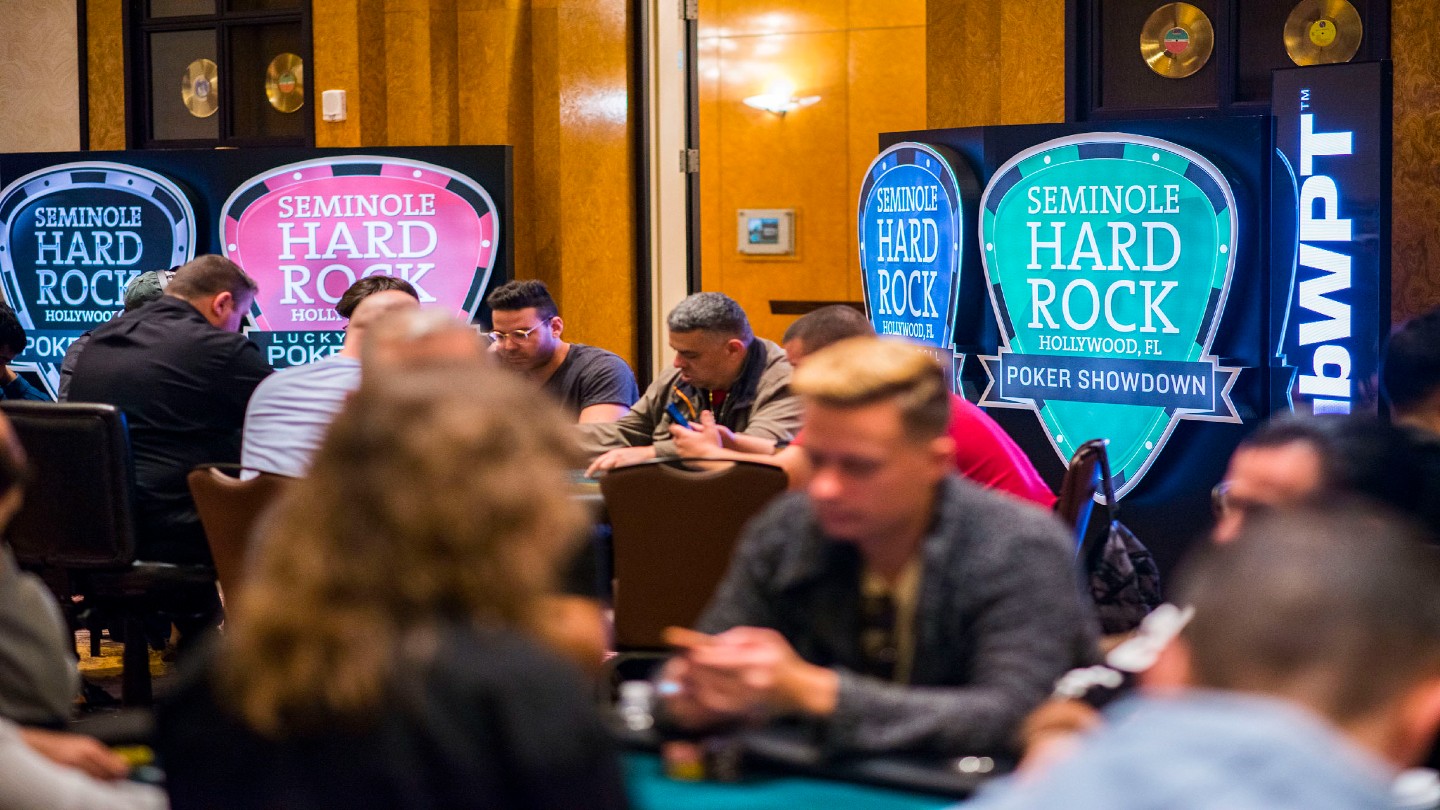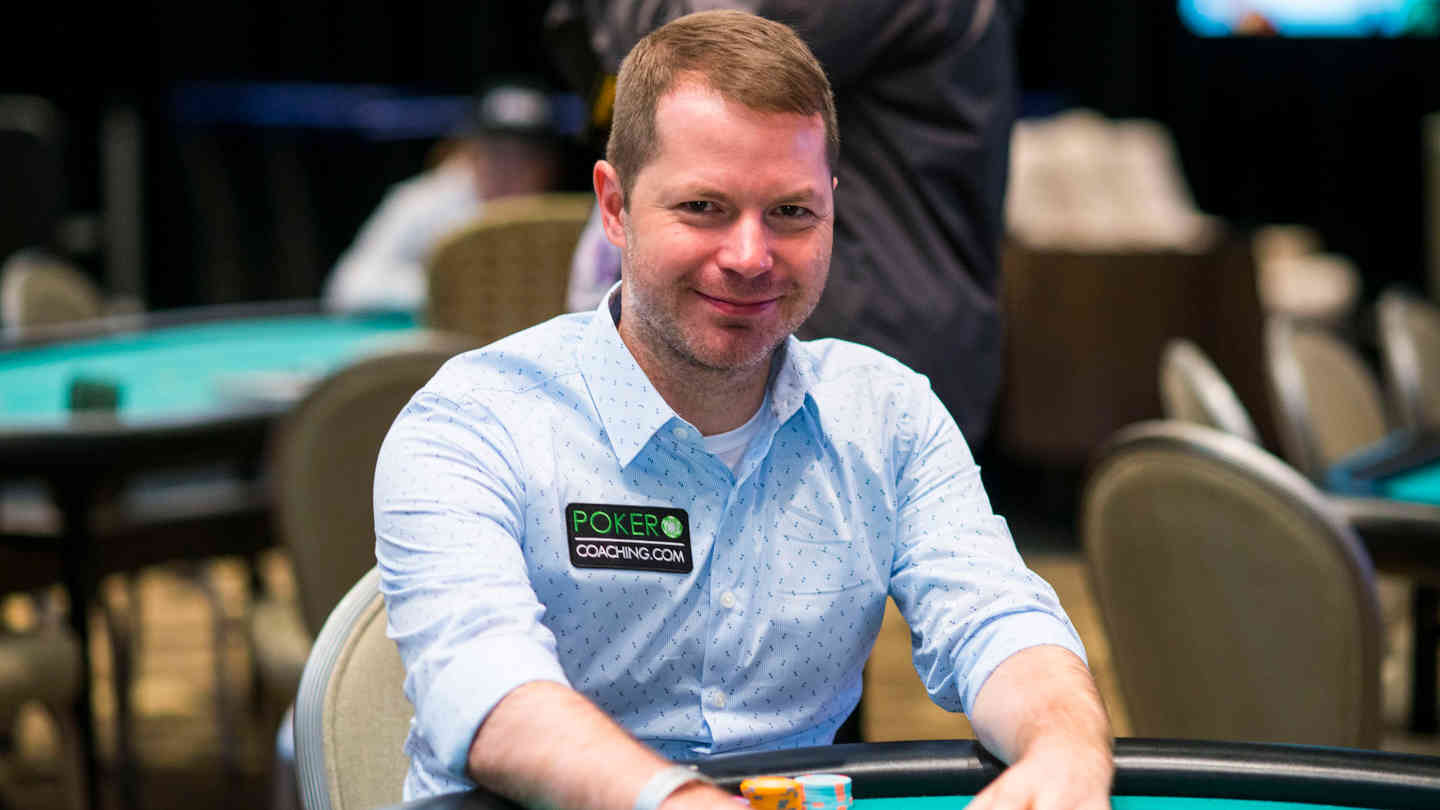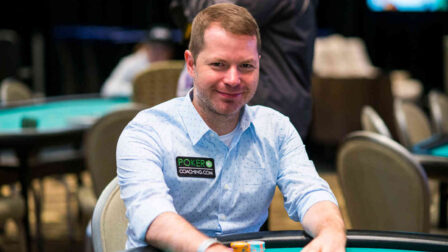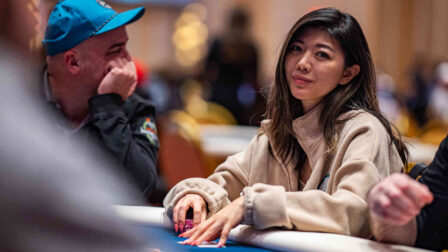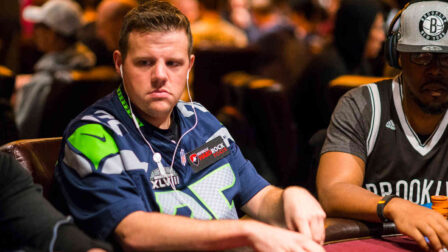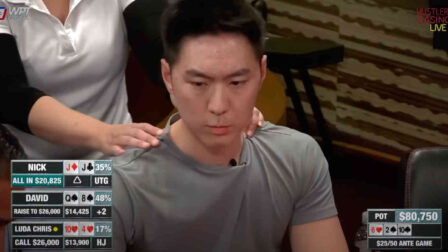Poker Positions: How to Get the Most Value from Different Seats at the Table
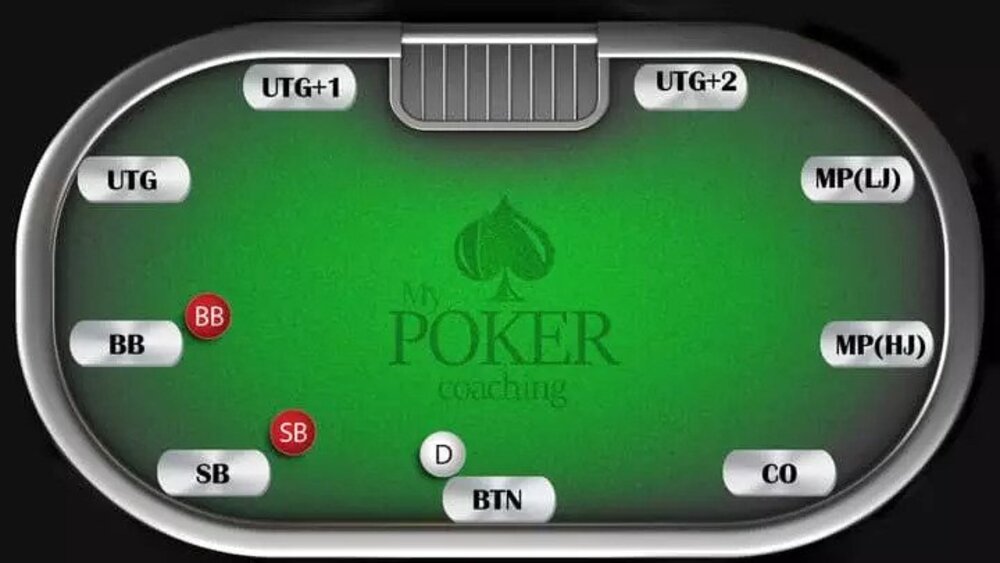
One of the first things you hear when you start learning poker is that the position is essential. Some even emphasize the importance of poker positions at the table and tell you that your seat can be even more important than the cards you have.
But what does this really mean?
New players often develop a completely wrong idea of poker table positions, even to the point where they believe to be “in position” when they act first.
In this article, I will explain everything you need to know about different positions and why it is a crucial thing to evaluate to make better decisions.
Poker Table Positions – Understanding Different Seats at the Table
Let’s start at the top with poker position names. Every seat at the table has its own name, and you’ll often come across this poker terminology in various strategy videos and articles. Knowing what these different names refer to is crucial to any further studying of the game.
First of all, there are four main groups of poker positions:
- Early positions (UTG, UTG+1, UTG+2)
- Middle position (MP, Lojack, Hijack)
- Late position (Cutoff, Button)
- Blinds
Players who are first to act before the flop are sitting in an early position, the next few players acting after them are in the middle seats, followed by the players in the late position. Finally, there are always two players sitting in the blinds if we are talking about Texas Hold'em poker.
Poker Position Names
In a standard 6 or 9-handed game, every position is assigned a particular name.
This positional name is referred to in hand analysis even to the point where it’s preferred over the player’s actual name or nickname.
For example, you’ll often hear:
“The UTG opens for three big blinds, the cutoff calls, and the button 3-bets to 15 blinds. Everyone in between folds, and the action gets back to UTG.”
If you don’t know poker position names, this can be very confusing, of course. So, let’s get that part out of the way.
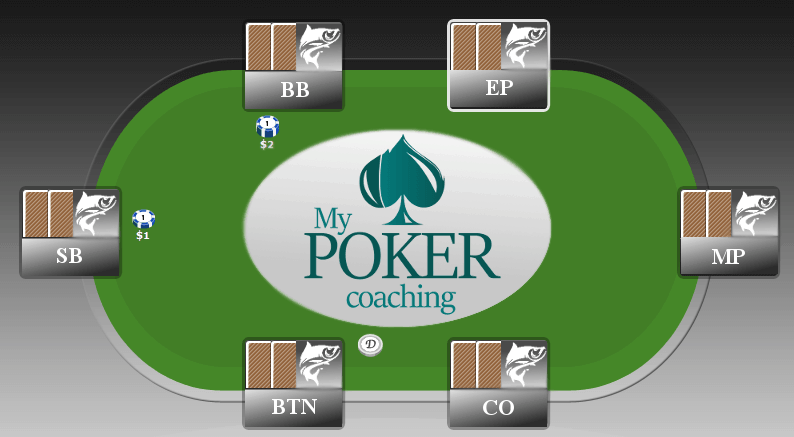
For 6-max, you have:
- Under the Gun (UTG): The first player to act before the flop, seated immediately to the left of the big blind
- Hijack: (HJ) The player sitting to the left of the UTG. Hijack sometimes is also called MP (middle position).
- Cutoff (CO): The player seated to the left of the Hijack and to the right of the Button.
- Button (BTN): The player to the right of the Cutoff and to the left of the Small Blind.
- Small Blind (SB): The player who posted the small blind before the flop sits to the left of the BTN.
- Big Blind (BB): This player sits to the left of the small blind and is the last to act preflop.
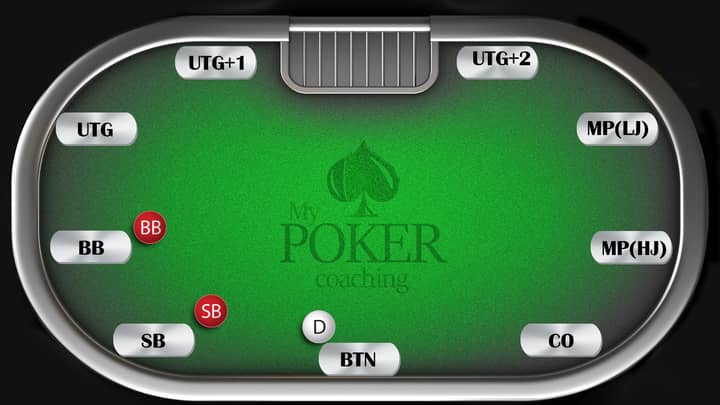
Here is poker position layout for a full-ring game:
- UTG – Under The Gun
- UTG+1 – Under The Gun + 1
- UTG+2 – Under The Gun + 2
- MP1 (LJ) – LoJack
- MP2 (HJ) – HiJack
- CO – Cut-Off
- BTN – Button
- SB – Small Blind
- BB – Big Blind
So, now you have a good idea of what people talk about when referring to cutoff or hijack. Also, it’s important to memorize these poker position names moving forward, as I’ll be going over specifics for each of these positions later in the article.
Strategy for Different Poker Positions – What Hands Should You Play?
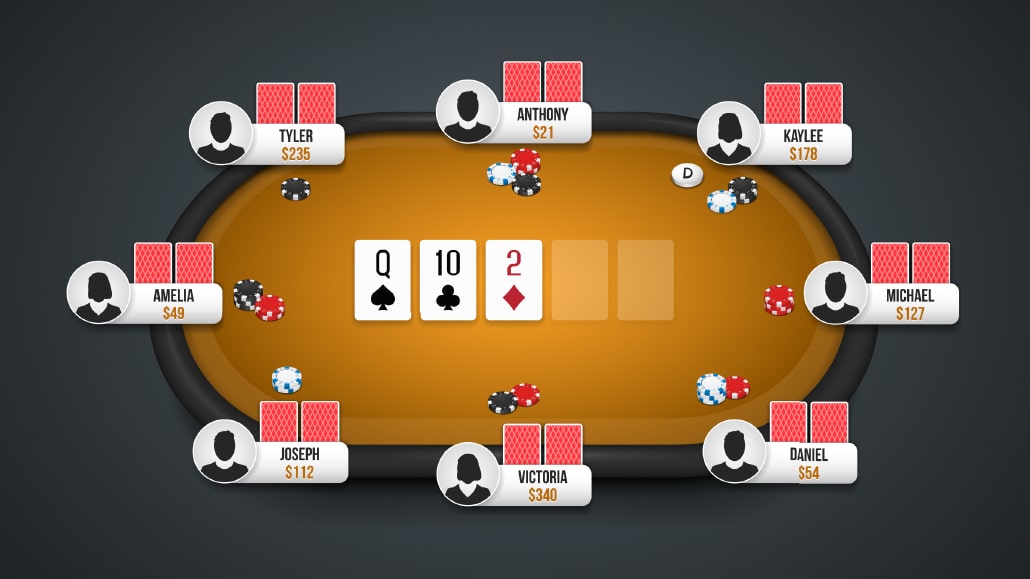
In this section, we will define a range of hands you should be playing when first in from every position.
For this, I will use poker software to illustrate how your hand selection should change as you move around the table. The percentage of hands you’ll want to play from first positions is very narrow compared to the range of hands you’ll play from the button.
The earlier you are, the less information you have on other players and more opponents behind you, which means the odds of someone having a big hand increases.
Therefore, you want to play tight at early seats. As you get to the button and only have blinds left to act, you can afford to widen your range.
So let's dive into the actual strategy and see opening ranges by position for a standard 100 big blind stack depth.
UTG – 10% of hands
The first position I will discuss is the earliest one there is, namely Under the Gun or UTG. There is a straightforward rule to follow when playing from under the gun, and that’s being very tight.
When you’re first to act in a full-ring scenario, you should only be opening with about 10% of your hands.
Depending on the table and how comfortable you are, you can deviate slightly from the UTG poker chart below, but I wouldn’t suggest going too far off. With so many players left to act, you need to stick to good poker hands.
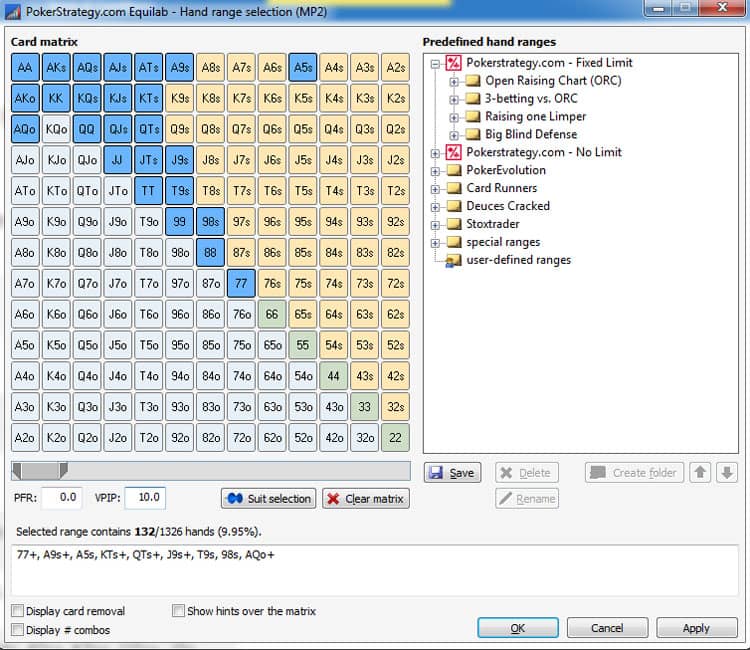
Some of the hands indicated on this chart probably won’t be in everyone’s range. If you’re not comfortable, I’d say you can remove hands like A9s and 98s to avoid tricky spots.
However, if you feel like you’re one of the better players at the table, there is no reason to avoid opening these holdings and then playing the hand accordingly.
UTG+1 – 11% of hands
As you move one position to the left, not too much changes. You’re still in a very early position, so your opening range doesn’t change all that much.
Playing around 10%-11% of your hands from UTG+1 is the way to go.
You can add a few more hands, but if you were to use the same chart for your UTG and UTG+1 strategy, you wouldn’t be making a mistake.
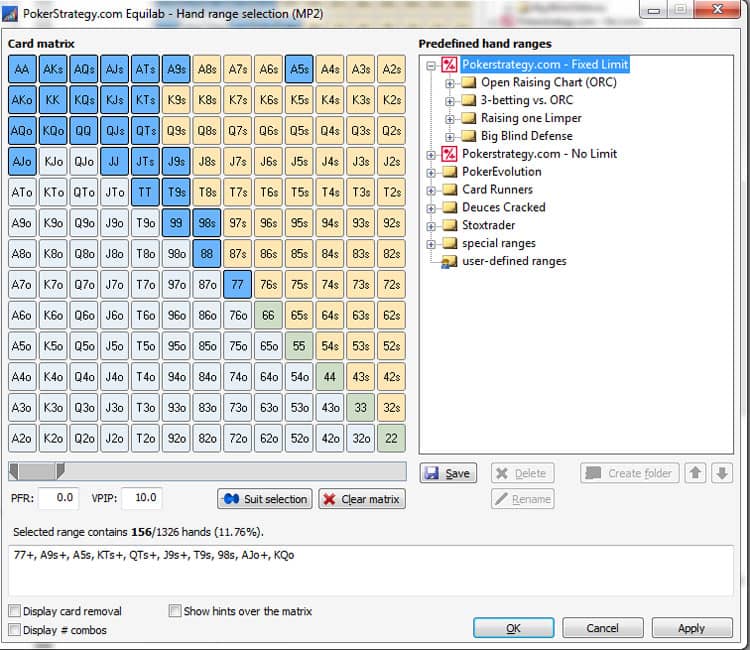
What you’ve probably noticed is that you don’t want to be playing any weak aces from these positions, with the exception of A5s.
Although they have some blocking value, these hands are bad candidates because they can get you in tricky spots after the flop, as the likelihood of someone having a better ace is quite high.
UTG+2 – 13% of hands
The UTG+2 position chart includes some extra hands, bringing your total range to about 13%. You still want to stay very tight, but you can now add more suited aces to the mix and feel more confident with hands like KQo.
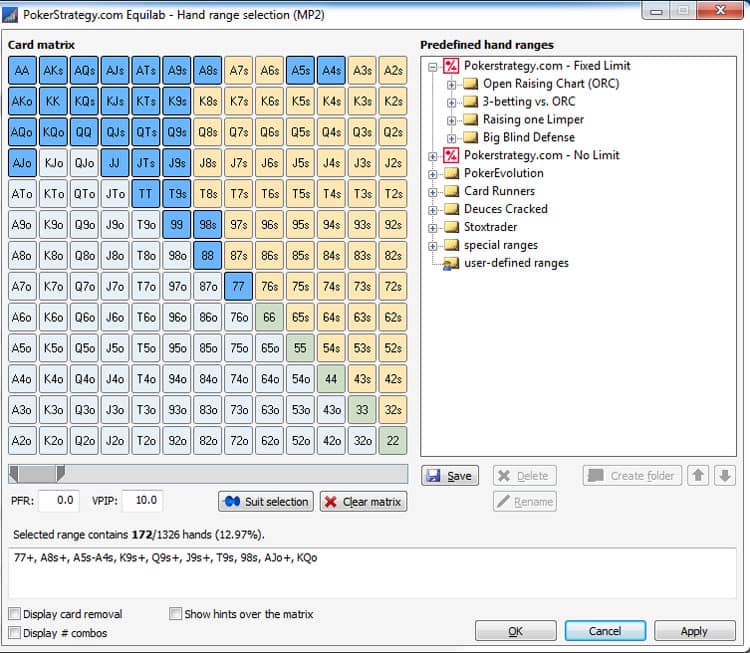
Still, you should be very careful with the lower part of your range, especially when faced with a 3-bet.
Unless you have a reason to believe someone is 3-betting you lightly, you should be ready to get rid of weak aces and hands like KQo.
Every now and then, you might consider 4-betting as a bluff, but calling and playing these hands out of position is usually not a good idea.
Middle Position 1 (MP1, Lojack) – 16% of hands
As you leave the early position spectrum, you can start to open with more hands. This will also be the first position in a 6-max table, so you can be using the same ranges in MP1 at a full-ring game and UTG in 6-max.
As you can see, the middle position chart for LoJack includes more pocket pairs (down to pocket fives) and the full spectrum of suited aces. Then, there are many more suited connectors like 89s and 78s.
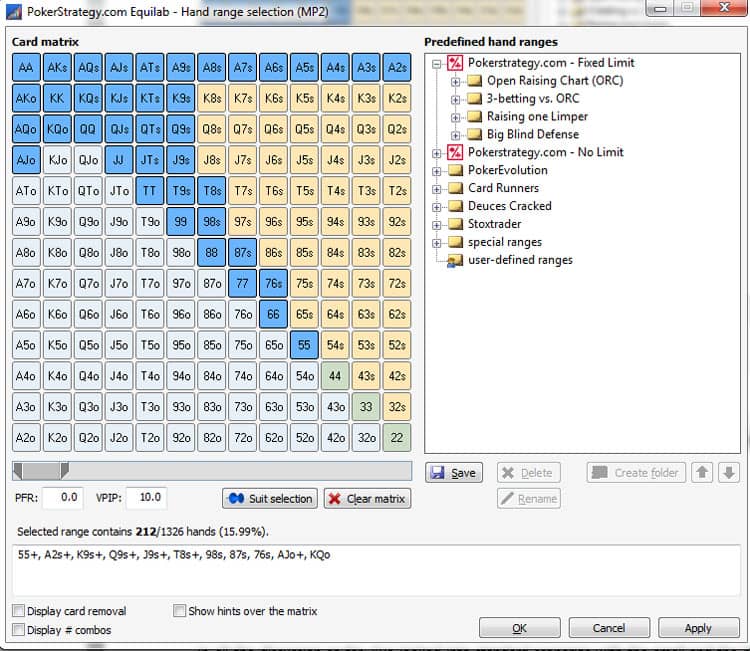
Still, your opening hand range shouldn’t contain too many unsuited A-high hands because you want to have a decent balance and keep the total at around 16%.
On a more passive table, you can probably include hands like ATo and KJo as well, but I wouldn’t go much lower than that.
MP2 (Hijack) – 20% of hands
You can find this position named as MP2 or HiJack, but the technical term you want to use isn’t all that important. It’s much more important to know how to have a good hijack poker opening range.
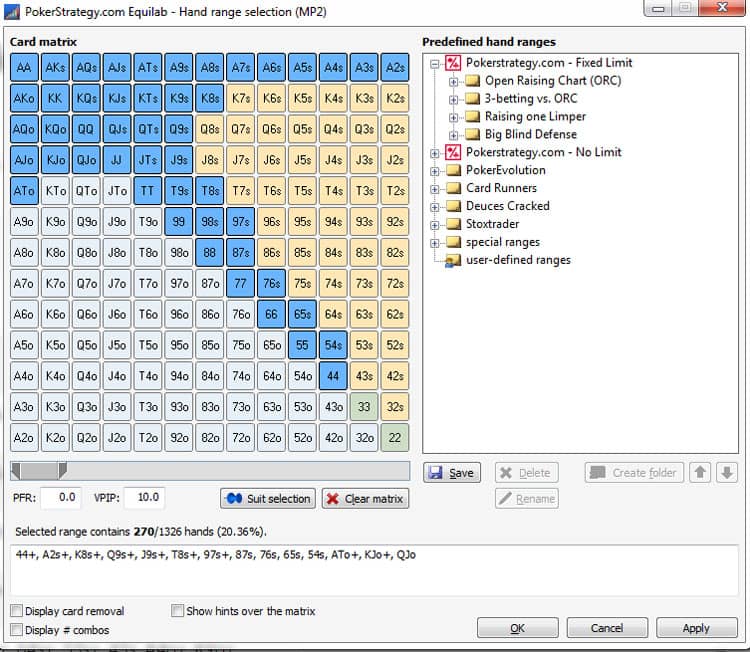
You should be opening about 20% of your entire holdings from this position, and you’ll want to have a fair number of suited connectors in there.
As you can see, you can now start opening more unsuited hands as well, such as KJo and QJo.
Interestingly enough, you’re still supposed to stay on the safe side with your unsuited aces. I’ve already explained the reasoning behind this, and it still applies when you’re in the hijack position.
While there are fewer people to get through, you could still run into someone with a bigger ace and lose a decent chunk of your chips on an Ace-high board.
The reason why suited aces are preferred is that they offer much more playability. You’ll often have a direct or backdoor flush draw as a backup or maybe even an inside straight draw, which gives you many more options.
Not just in terms of made hands but in terms of staying aggressive with a decent draw and winning a pot that way.
Cutoff – 26% of hands
The cutoff is the first of two genuinely late positions where you can start expanding your opening range significantly.
This is because now you only have one player that can have a position on you – the button. Small and big blinds can decide to get involved, but they’ll always be out of position post-flop, which means you’ll have a much higher degree of control in a pot.
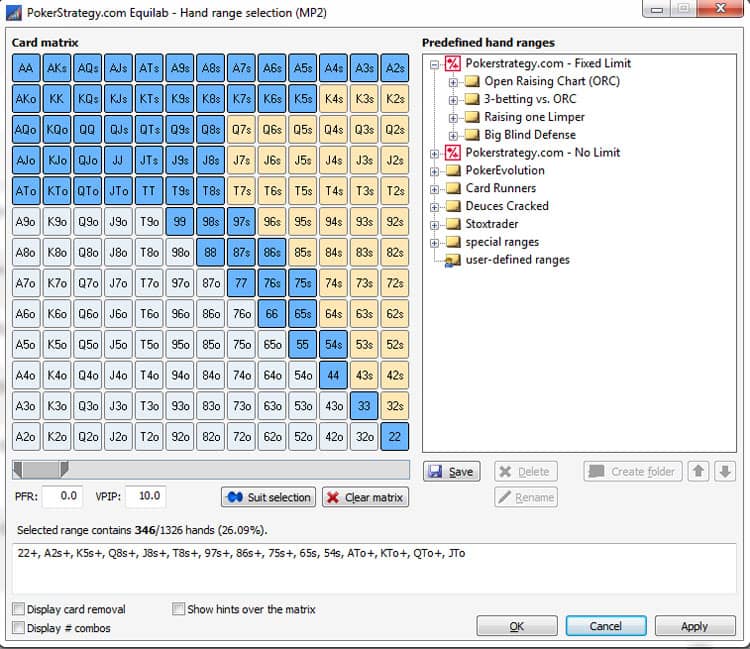
The suggested cutoff range is about 26%, but I would say that, in most games, you can get away with opening wider. Hands like A9o and A8o are more than good enough to open with unless you have a really tough player on the button who regularly plays back at you.
As you gather more experience, you can expand your raising ranges and start including some non-GTO hands against weaker opponents.
But for a beginner player, these charts are easy to memorize and will help you stay out of trouble. Most poker training sites like Upswing Poker Lab or even Jonathan Little poker coaching suggest to follow these tips, so you should be good!
Button – 40%+ of hands
There is a significant jump compared to the cutoff because now you don’t have to worry about anyone having a position over you, so your EV goes up. As already explained, the poker button position is the most powerful of all seats at the table.
You’ll always have the last say on the flop, turn, and river and will be in the driving seat for the rest of the hand no matter what, so you can open more hands.
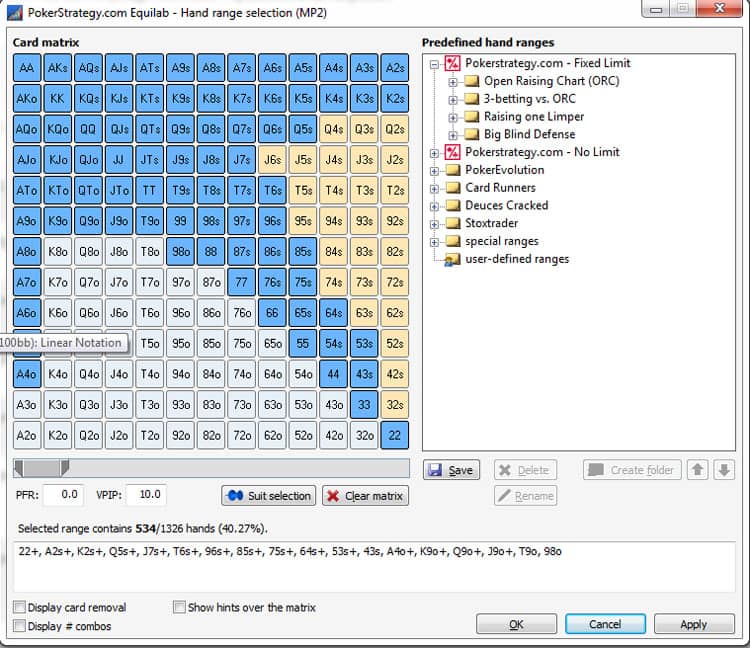
That’s why you’ll want to be opening about 40% of your entire range, and as you can see, that means some hands that you wouldn’t consider at first.
I’m guessing that some of you are looking at this chart, thinking no way this is correct. Do you really want to raise with a “garbage” hand like Q5s? How is that a raising hand?
Everything depends on your poker positions. So, while you’d never even consider Q6s from UTG, it becomes very playable from the button.
In fact, you’re better off being on the looser side here, i.e., it’s better to be opening with as much as 50% of your range than with just 30%.
Small Blind – around 50% of hands
You’ve probably noticed that so far, there were only two options – raise or fold. With the GTO poker approach, there is no room for limping first from other positions. If you want to get involved in a pot first to act, you do it by raising.
In the small blind, you could implement a complex liming range as well, but since we are talking about 100bb games without any ante, let's assume we will still be raising or folding.
When in the small blind, you’ll be opening with almost 50% of your entire range. You’re up against a random hand and already invested in the pot, so you don’t want to give free equity to the big blind by folding too much.
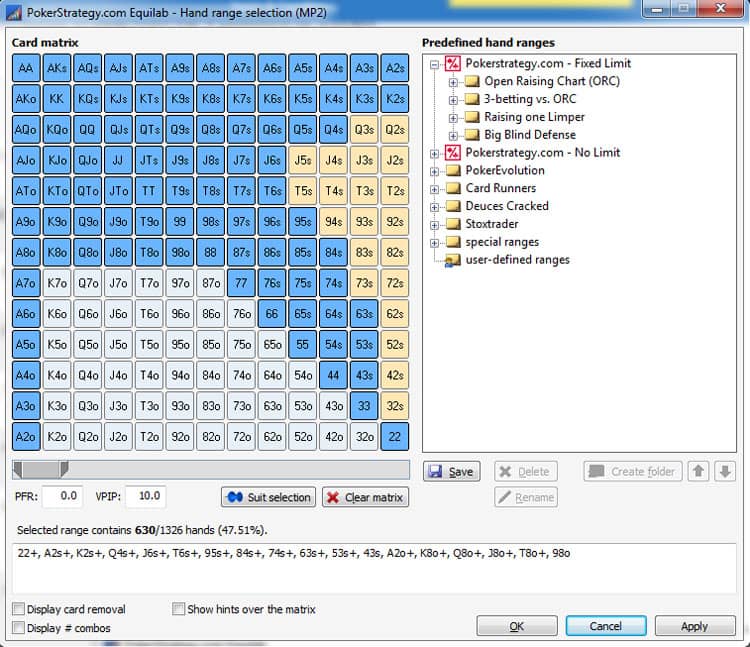
If you do have a limping range, though, make sure to also keep some strong hands in it to prevent the big blind from always raising when you just complete, as they’ll know you’re only doing it with weak hands.
The bottom line is you’ll want to play many hands from this position as you don’t want to give up the money already invested in the pot, and you are getting great odds to play.
Big Blind – defending range depends on your opponent seat at the table
The big blind is the only position that never gets to act first before the flop. You’ll either win the pot when everybody else folds, have an option if one or more players limp in, or have to find an appropriate response to a raise.
So, there is no “raising first” range for the big blind. Instead, you have a defense range, i.e., hands you’ll want to continue with when facing a raise.
Your defense range will depend on what position the raise comes from, which makes a big blind poker strategy another topic of its own.
That said, for quick guidelines on how to approach this position, I would suggest playing very cautiously out of the big blind against early position raises. If players are sticking to tight ranges as they should, you’ll be up against a very strong hand on average.
So stay away from weak aces and trouble hands like KTo and J9o because it could be hard to realize your equity.
You can defend with smaller pairs and stronger-suited connectors. However, only do that when you’re deep enough and believe the opponent will overplay their big pocket pair, for example, when you catch a favorable flop for your range.
As you play against players in later positions, you just keep expanding your defending ranges based on how much they are opening. For this, you will need to analyze some situations with poker solvers since there is no way to break down all possible scenarios in this article.
Why Are Poker Seat Positions So Important?
Even if you feel like you’re getting tired of hearing about it, bear with me. There aren’t many poker tips that will be as important as this one throughout your poker career.
If you watch the pros play, you will notice that they significantly expand their poker ranges when playing on the button, the one spot at the table that guarantees you will play the hand in position if it goes to the flop.
The advantages of playing as many hands as you can in position are many, and they are very real, so I will demonstrate a few of the most important ones and show you exactly how playing in position can work in your favor with specific hand examples.
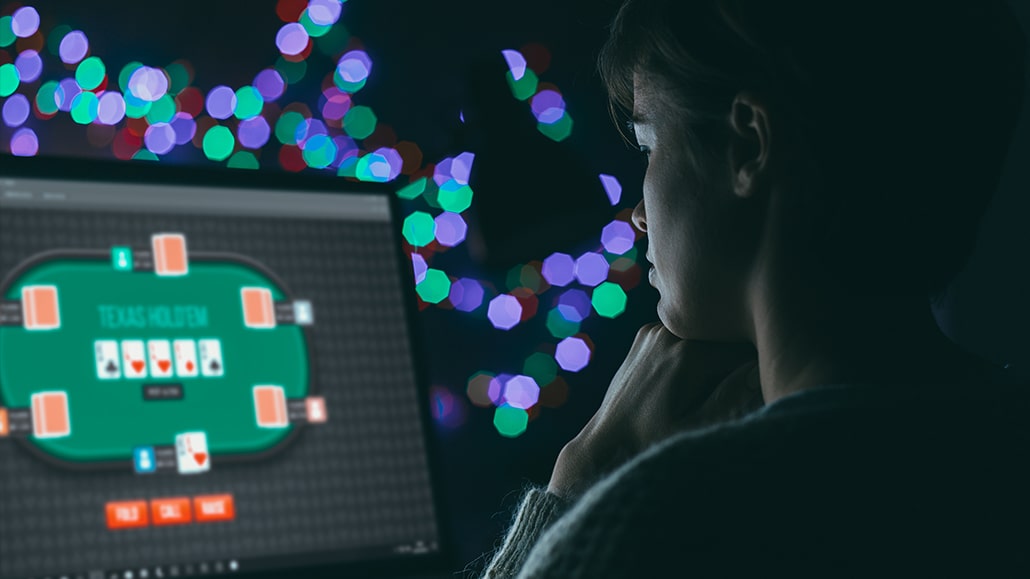
In Position Players Win More Pots Uncontested
The first thing that playing in position allows you to do is win a lot of pots completely uncontested. This starts with preflop play, as playing from the button or cutoff allows you to steal the blinds with a raise quite often without much fight.
However, the more significant part of the equation comes in pots that do go to a flop, as players in the blinds or early position limpers defend against your raises.
In such situations, you will get many opportunities to steal the pot on the flop, even with the smallest of bets, which can add up to a lot of chips over the long run.
In Position Players Control the Pot Size
Pot control is a concept that most amateur poker players don’t understand, but that will help you navigate hands to your liking and take opportunities away from your opponents.
By playing in position, you can significantly impact your opponents’ actions when you want them to put chips into the pot and when you don’t.
A great example of this comes when you hold medium-strength hands in spots where other players might be setting up a check-raise.
In such situations, a simple checkback will allow you to avoid bloating the pot and possibly get to showdown without investing your whole stack.
In Position Players Can Take a Free Card
While many new-school players like to play an ultra-aggressive style and bet most draws in online poker games, there is something to be said about taking your foot off the gas occasionally.
Sure, aggression generally pays off in poker, but we have all been in a situation where we fire out a bet and know the opponent will move in on us even before we throw those chips in.
The power of position in poker is in the ability to dictate the tempo of the hand, and taking a free card when you know you are likely beat but could get there is often a good idea.
In Position Players See More Tells
Whenever you play a hand of poker in position, you are forcing your opponents to play before you, and this means they have to take action and potentially give away tells that you can use to your advantage.
In a live poker setting, players give up many things by how they move their chips, signalize a check, or announce a bet size.
Even in real money poker apps, sizing and timing tells are very real things, and a savvy poker player can use them all to his or her advantage.
By playing more hands in position, you will see your opponents act on their hands on various streets before you take action, soak up the information, and decide what to do with all the extra info in hand.
Position in Poker – Vital Considerations
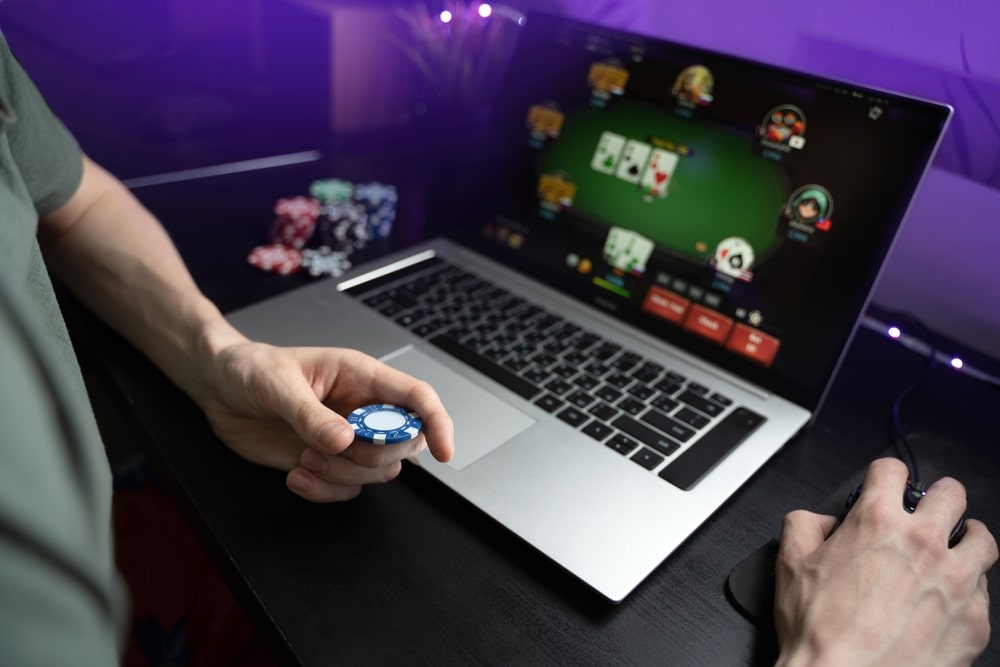
We already covered poker positions and the most important things to consider, but I want to make sure you understand the difference between relative and absolute positions and know how to adjust in the environment with extra blinds. Let's start with the former.
Relative vs. Absolute Poker Position
Texas Hold’em is a dynamic game. Things change based on the actions of other players. When thinking about poker table positions, this is an essential consideration.
Let’s say the MP player opens, and you decide to call from the cutoff. You have a position over them, so that’s good. However, the button decides to call, as well. Now, you have a position on the MP, but the BTN has a position on the MP and you.
This is the difference between relative and absolute positions.
There is only one seat at the table that can know for sure they’ll have a positional advantage on everyone for the entire duration of a hand, and that’s player on the button.
They have the absolute position, and that’s what makes this seat so powerful. No matter what other players do, they can’t take away the positional advantage from the button, unless you fold.
All other positions are relative. You can hope or expect to have a position over a particular player, but you don’t know what players still to act will do.
If one of them decides to join, you will lose the advantage, and you always have to think about this possibility.
Adjusting With Ante In-Play
In all the discussions so far, I’ve looked into standard scenarios with the small and the big blind. However, sometimes there will be some extra chips in the pot added via poker ante.
Poker ante is a mandatory amount that all players, regardless of their poker positions, have to post before the hand.
Usually, it is around 10% of the big blind but can be more or less. So, for example, players post a small blind (100), a big blind (200), and then everyone, including the small and the big blind, post an additional 20 chips and adds them to the pot.
So, instead of 300, because of antes, the pot grows to 420 even before the hand starts.
Poker ante is more common in MTTs, so it is essential to adjust your poker tournament strategy. It is also found in some cash games, especially at the higher levels.
When talking about poker ante in terms of positions, the general adjustment you’ll want to make is to expand your raising range from all positions.
Since the pot is bigger and there is more to fight for, you’ll want to be more aggressive.
This doesn’t mean going crazy, of course. You can look at the default charts and then adjust by adding a few more hands that are just outside of the range. Or, if poker training sites suggest raising a particular hand 40% of the time, you can look to raise 65% to 70% with it due to poker ante.
If you’re playing from the big blind, you’ll want to adjust by defending more in poker games with antes.
Poker Positions With Straddle in Play
Sometimes in cash games, the action just isn’t enough for the players, or they want to make the game more entertaining. Instead of raising blinds, which isn’t a common practice, especially in casinos, players often choose to post a poker straddle.
It is basically a third blind. Usually, it is twice the size of the big blind, and it is posted by the UTG player.
So, in a $1/$2 game, the UTG player will usually post a $4 straddle if they choose to do it.
Straddle changes the traditional order of poker positions because the UTG now effectively becomes the big blind.
It is essential to know that straddle in poker doesn’t change any postflop rules, i.e., once the action before the flop is over, the order is restored, and the action continues as always.
It is only before the flop that the straddle gets the last action but has to pay for this privilege as they have to post before seeing their hole cards, just like the blinds.
You won’t find straddles in tournaments. These are reserved exclusively for cash games, and the exact rules surrounding them may vary.
In general, posting a straddle is a wrong choice because the slight advantage of being the last to act pre-flop isn’t enough to justify putting two big blinds without seeing your cards.
Summary: Mastering Positions In Poker
Once you’re done with basic poker rules and hand rankings, understanding poker table positions should be next on your list when starting out.
As you can see, your position has a significant influence on the range of hands you’ll want to play, so without this knowledge, you’re bound to make serious mistakes.
If you make an occasional mistake playing a hand that’s right on the edge, that’s not a big deal. It may be a small mistake, but it’s not the one that will cost you a lot of money.
However, playing without any structure and trying to make up your own ranges as you go can be very dangerous.
Hopefully, this article was able to teach you more than just poker position names. It contains a lot of information, so feel free to come back to it if you feel like you need to study a particular part a bit more. Or you may even get one of the poker books to dive deeper into these topics.
With time and experience, these charts will become second nature to you, and before you know it, you’ll know precisely which hands you should and shouldn’t be playing from every position at the table.
Quick poker positions takeaways:
- Understanding poker positions is a crucial part of a successful poker strategy
- Being in position provides you with a significant advantage so you can play more hands
- Do not play too many hands from early spots at the table
- Memorize positions and hands to open from every seat at the table
- Adjust these opening ranges based on your competition
- Raise more against recreational players or weak opponents sitting in the big blind












